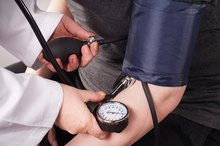Electrolyte Imbalance & Bradycardia
Your heart beats fewer than 60 times in a minute if you have bradycardia, or a slower-than-normal heart rate. For some people, such as trained athletes, a slower heart rate does not cause problems. However, for others it can be a serious problem because their heart may not pump enough oxygen rich blood throughout their body. Electrolyte imbalance may contribute to this condition.
Significance
Any abnormality in the balance of minerals, which are normally dissolved in your body’s fluid, is a primary danger to your heart, according to the University of Maryland Medical Center. These minerals include phosphate, potassium, calcium and magnesium. Reduced fluid and mineral levels create a condition called electrolyte imbalance. The electrolytes potassium and calcium are needed to maintain the electric currents for a normal heartbeat 1.
- Any abnormality in the balance of minerals, which are normally dissolved in your body’s fluid, is a primary danger to your heart, according to the University of Maryland Medical Center.
- The electrolytes potassium and calcium are needed to maintain the electric currents for a normal heartbeat 1.
Considerations
Benicar & Potassium
Learn More
If your doctor suspects you have bradycardia, she will likely include a blood test to screen for electrolyte imbalance, since this is an underlying condition that can contribute to the condition, according to the Mayo Clinic. Other blood tests may screen for hypothyroidism or an infection. Your doctor also will likely use an electrocardiogram, or EKG, which is a primary tool used to evaluate bradycardia.
Causes
Dehydration can lead to an electrolyte imbalance that affects your heart rate, according to Merck 2. Vomiting for a long time, having diarrhea or using diuretics can cause you to have a potassium level that is too low, which can lead to heart problems. Unless fluids and minerals are replaced, an electrolyte imbalance can become life-threatening, according to the UMMC.
Warning
Can Too Little Sodium Cause Heart Palpitations?
Learn More
People who have the eating disorders bulimia and anorexia sometimes suffer bradycardia due to electrolyte imbalance. The risk of heart problems increases when a person uses ipecac, a drug that makes you vomit, according to the UMMC.
Treatment
Treatment for low potassium levels involves ingesting potassium supplements in liquid or tablet form, or eating foods that are rich in this mineral. If you are taking a diuretic that causes you to excrete potassium, your doctor may switch you to an alternate type of diuretic called a potassium-sparing diuretic. Treatment for low calcium levels also involves supplements unless you have a disorder that leads to low calcium levels. If that’s the case, the disorder, such as a low parathyroid hormone level or deficiency in vitamin D, must be treated, according to Merck.
On the other hand, if you have a potassium level that is too high you need immediate treatment, according to Merck. If your heart rhythm is abnormal, you need calcium administered intravenously to protect your heart. You also may be given drugs that prevent potassium from being absorbed in your body.
- Treatment for low potassium levels involves ingesting potassium supplements in liquid or tablet form, or eating foods that are rich in this mineral.
- Treatment for low calcium levels also involves supplements unless you have a disorder that leads to low calcium levels.
Related Articles
References
- Merck: Electrolytes
- Merck: Problems with Electrolyte Balance
- Braun MM, Barstow CH, Pyzocha NJ. Diagnosis and management of sodium disorders: hyponatremia and hypernatremia. Am Fam Physician. 2015;91(5):299-307.
- Braun MM, Barstow CH, Pyzocha NJ. Diagnosis and management of sodium disorders: hyponatremia and hypernatremia. Am Fam Physician. 2015;91(5):299-307.
- Balcı AK, Koksal O, Kose A, et al. General characteristics of patients with electrolyte imbalance admitted to emergency department. World J Emerg Med. 2013;4(2):113–116. doi:10.5847/wjem.j.issn.1920-8642.2013.02.005
- Balcı AK, Koksal O, Kose A, et al. General characteristics of patients with electrolyte imbalance admitted to emergency department. World J Emerg Med. 2013;4(2):113–116. doi:10.5847/wjem.j.issn.1920-8642.2013.02.005
- Lee JW. Fluid and electrolyte disturbances in critically ill patients. Electrolyte Blood Press. 2010;8(2):72–81. doi:10.5049/EBP.2010.8.2.72
- American Association for Clinical Chemistry. Basic metabolic panel. Updated December 2, 2015.
- El-Sherif N, Turitto G. Electrolyte disorders and arrhythmogenesis. Cardiol J. 2011;18(3):233-45.
- Prihantono P, Palinggi E, Haryasena H. Surgical treatment for parathyroid adenoma: a case report. Open Access Maced J Med Sci. 2019;7(15):2497–2501. doi:10.3889/oamjms.2019.418
- Joseph TT, DiMeglio M, Huffenberger A, Laudanski K. Behavioural patterns of electrolyte repletion in intensive care units: lessons from a large electronic dataset. Sci Rep. 2018;8(1):11915. doi:10.1038/s41598-018-30444-3
- Belval LN, Hosokawa Y, Casa DJ, et al. Practical hydration solutions for sports. Nutrients. 2019;11(7):1550. doi:10.3390/nu11071550
Resources
Writer Bio
Linda Tarr Kent is a reporter and editor with more than 20 years experience at Gannett Company Inc., The McClatchy Company, Sound Publishing Inc., Mach Publishing, MomFit The Movement and other companies. Her area of expertise is health and fitness. She is a Bosu fitness and stand-up paddle surfing instructor. Kent holds a bachelor's degree in journalism from Washington State University.









